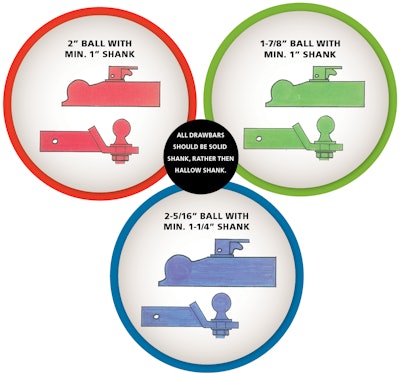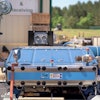
Editor's Note: The following information was provided by Rick Ream of ARA Insurance Services during the seminar program at The Northwest Rental Conference in Seattle, WA, Nov. 2-4.
The misidentification of coupler to hitch ball size has been one of the most talked about issues with trailer hook-up, but it continues to be a significant problem at rental stores. People either get too busy or don't pay enough attention to detail, thus failing to notice the incorrect ball size while hooking up to the towing vehicle. The AIS trailer ball gauge has helped, but is just not used enough to make a significant difference.
Hitch balls are not all created equal
Although seldom used in rental, 1-7/8-in. hitch balls are rarely rated over 2,000 pounds GTW, even with a full 1-inch shank (the 1-7/8-inch ball is most commonly made with a 3/4-inch shank). It's generally agreed that 2-inch and 2-5/16-inch hitch balls and couplers are the most frequently used sizes in the rental industry.
Two-inch balls are available with three basic shank sizes: 3/4-inch, 1-inch and even 1-1/4-inch. There is a very broad range of GTW with the 2-inch size hitch ball. Surprisingly, a 2-inch ball with a 1-inch shank can be GTW-rated as high as 10,000 pounds if made from high-quality forged steel. The average rating is 5,000 to 6,000 GTW, but lower-quality 3/4-inch shank models (mostly made in China) are only rated from 3,000 to 3,500 GTW. All hitch balls sold in the USA and Canada have the GTW permanently stamped on the flat section at the top of the ball. The numbers are frequently covered by dirt, grease or rust, however, and not always legible due to exposure from outside elements.
Here's a disturbing fact: the most frequent question I hear from folks at the rental counter is "What size is your hitch ball?" rather than, "What size is the ball, and what is the ball and drawbar rated for?" Ultimately, the burden of establishing whether the customer's equipment is up to the job falls on the yardman. It takes a well-trained technician to spot some of the hidden hazards associated with various ball and drawbar combinations. For example, a drawbar may be stamped for 5,000 GTW and have a 2-inch ball mounted on it. If the hole in the drawbar is 1 inch, however, and the ball has a 3/4-inch shank, the shear breakaway of the ball is reduced by more than 50 percent. In this combination, the 2-inch ball has been reduced to a GTW of something less than 1,750 pounds.
Another serious potential problem for rental stores is inside-thread (female) hitch balls. Due to the fact that the threads are hidden, it's impossible to tell if the bolt that secures it is long enough to meet its rated GTW. If the vehicle owner installs a ball with a bolt too short for the application, and only two or three threads secure the ball to the coupler, it can easily break off while towing rented equipment. A second problem with this ball type has to do with the bolt grade that secures it. Unless the technician is familiar with bolt grades and actually gets under the hitch to inspect the bolt, this could be a disaster just waiting to happen. For example, an inside-thread ball with a stamped rating of 5,000 GTW improperly installed with a Grade 2 bolt would have its actual GTW significantly reduced by as much as 50 percent or more (Grade 5 or 8 is recommended).
Although not readily available with female threads, 2-5/16-inch hitch balls have much the same variance of GTW as the 2-inch ball. Most construction vehicles are equipped with 2-5/16-inch hitch balls that have 1-1/4-inch shanks rated at 10,000 pounds. It's not unusual to see 2-5/16-inch balls with 1-inch shanks rated at 5,000 GTW - or even 2-5/16-inch balls with 3/4-inch shanks rated at only 3,500 GTW (these are often purchased at cut-rate tool stores that import tools and equipment directly from China).
As with the 2-inch ball, if installed on a drawbar drilled for a larger shank, it's an accident waiting to happen, barely visible to even the well-trained and most competent technician.
Drawbars have differences too
Drawbars further complicate an already confusing position for the rental business. Drawbars are rated and generally are stamped with rated GTW. But like hitch balls, they're subject to rust, dirt, grease and outside elements that sometimes make it almost impossible to read them. In addition, many drawbars are "homemade" or "shop-built" and have no ratings on them at all.
As a general rule of thumb, a hollow-shank Class 3 drawbar that fits a standard 2-inch receiver is rated between 5,000 and 6,000 GTW. A solid-shank steel drawbar that fits a 2-inch receiver (Class 4) will generally be rated at 10,000 to 12,000 GTW. Class 3 drawbars have a 1-inch ball hole size and Class 4 have a 1-1/4-inch ball hole size. Hitch balls with 3/4-inch shanks can easily be mounted on either of these drawbars by the uninformed rental customer, potentially resulting in substantial loss or property damage. As mentioned above, balls with female threads can also be mounted incorrectly on both Class 3 or Class 4 drawbars. Either case can be difficult to almost impossible for even the most informed technician to spot unless a very careful inspection is part of the hook-up.
In addition, in some cases, it can be very hard to tell at first glance the difference between a Class 3 (hollow) or Class 4 (solid) drawbar. Sometimes a technician must sufficiently clean it to read its rating, or physically remove it from the receiver to tell the difference. Hitching a heavy trailer to a Class 3 drawbar with a 2-5/16-inch hitch ball could prove a very costly mistake.
So, do rental stores check each part of the hitch system before a rented trailer goes out? Do they check the ball size, ball TGW, ball shank size, female thread ball, drawbar TGW, Class 3 or Class 4 drawbar? What about mismatched shank size to ball hole size? In fact, all this has to happen each time, all the time and for every rental, even when the technician is pressed for time, or it's pouring rain, or the customer is in a hurry to leave. Do things get overlooked sometimes? Absolutely, but there is a solution.
The simple, three-step solution
1. Color code for safe hitchup every time. Color code will dumb down the hitchup procedure. This system makes it extremely easy for employees, supervisor or store owner to spot a mismatched ball/coupler, even from great distance. Consequently, it's much more difficult to make an error of this nature.
2. Include the rental store's own color-coded Class 4 drawbar and correct ball with every color-coded towable you rent.
3. Rental stores should convert from safety chains to coiled steel safety cables on all towables used for rental purposes. Along with the fact that the coiled cables look nice, they last much longer since they don't drag. More importantly, they prevent employees or renters from twisting the chain to reach a desired length. A twisted chain can lose up to 70 percent of its strength by levering over itself at impact. Chains dragged along the highway for much distance will be rendered useless in preventing a disconnect. The coiled steel cable is covered by a protective coating that allows the cable to adjust to the needed length without dragging or bouncing.




















